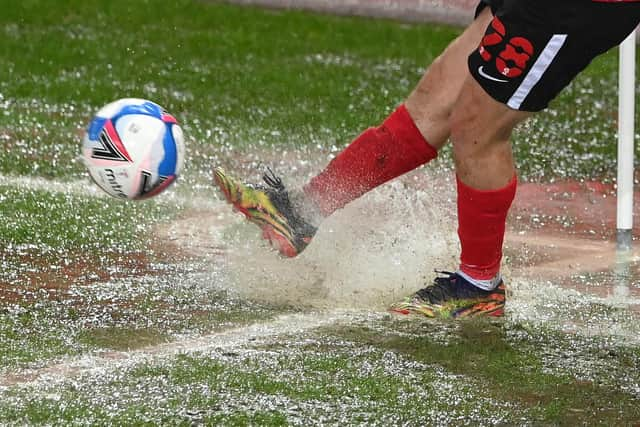Exactly what happened with the Stadium of Light pitch ahead of Sunderland's defeat to Plymouth
and live on Freeview channel 276
As the media started to descend on the Stadium of Light before Sunderland’s clash with Plymouth Argyle, a cursory glance at the pitch led many to linger close to the exits.
Heavy rainfall had left parts of the playing surface carrying large amounts of water and referee Robert Lewis was clearly concerned.
Advertisement
Hide AdAdvertisement
Hide AdHere’s exactly what happened on an evening where for large spells it was the playing surface dominated the discussion on Wearside:
5:15pm – The first pitch inspection
Upon arrival at the Stadium of Light, there were already a few concerned faces.
A few Sunderland players gingerly walked onto the playing surface and examined the portion in the middle of the pitch which was visibly carrying the most water.


Advertisement
Hide AdAdvertisement
Hide AdReferee Lewis and his team then entered the pitch to conduct a more formal inspection.
The tried and tested method of booting a ball up in the air and seeing if it bounced was employed, and the ball was moving freely. Indeed, despite there being clear amounts of surface water, the ball was still moving fairly freely throughout the first inspection.
There were two clear areas that were causing concern, though: the aforementioned area in the centre of the pitch, and the goalmouth in front of the Roker End.
It was the latter which most of the conversation centred around, with Lewis and his colleagues trying to assess how the ball was moving in this key area of the pitch.
Advertisement
Hide AdAdvertisement
Hide AdIn a bid to show how the ball was moving, four Sunderland players – Elliot Embleton, Luke O’Nien, Oliver Younger and Anthony Patterson – were brought onto the field and knocked a ball about in some of the more troublesome areas.
After over 20 minutes of surveying the surface, Lewis gave the green light.
The music began, the cones came out for the warm-ups and it was all systems go – for the time being, at least.
5:45pm – The vital work
At this point, it was time for the groundstaff to work their magic.
Advertisement
Hide AdAdvertisement
Hide AdAnd they deserve a great deal of praise for getting the game on, particularly given the limited timeframe they had between Lewis’ inspection finishing and the teams emerging for the warm-ups.
The roller was swiftly brought out and did a fine job of removing some of the standing water from the centre of the pitch.
While it far from eliminated the problem completely, this work proved vital in addressing one of the more concerning areas of the field – ahead of a second inspection an hour before kick-off.
6:00pm – The second inspection
As the team news started to creep out from both sides ahead of the game, all eyes were still quarely on the pitch.
Advertisement
Hide AdAdvertisement
Hide AdWith both sets of goalkeepers already preparing for the game, Lewis conducted another inspection of the surface.
This one was far quicker, and a lot more conclusive.
The work done by the groundstaff had alleviated some – if not all – of the major concerns over the pitch and it had showed little sign of worsening since the initial inspection.
Crucially, the rainfall had also slowed down and the forecast looked slightly more optimistic.
Game on, then.
7:00pm – Job done (for now)
As Plymouth strode forward to take the kick-off, there was still a concern that this game would not go the distance.
Advertisement
Hide AdAdvertisement
Hide AdThe pitch had been cut-up in some areas during the warm-up, as was perhaps to be expected, and the rainfall was growing heavier.
But thankfully, while the pitch did continue to cut-up as the first-half progressed, there was no sign of the surface ever becoming unplaybale.
There was the odd awkward bounce, and an early temptation to go longer than usual given the surface, but nothing that we haven’t seen before.
8:00pm – Not the night for white...
Plymouth were sporting their away kit for this fixture – and at half-time perhaps wished they had gone with their traditional green.
Advertisement
Hide AdAdvertisement
Hide AdTheir shirts were caked in mud, and many players changed strips at the break.
The pitch, for all it was cutting-up, at no point looked unsafe or unplayable and there spells where good football was played on it, too.
9:30pm – The short-term dealt with
But now for the long-term.
As Lewis brought to an end a contest that only hours before had seemed unlikely to start, the debrief began.
There was much to dissect from the performance of course, but the playing surface was a key conversation topic post-match.
Advertisement
Hide AdAdvertisement
Hide AdHead coach Lee Johnson was quick to praise the groundstaff for their efforts, and called for them to be given additional investment in order to help improve the pitches – not just at the Stadium of Light, but at the Academy of Light too.
"We're going to need to invest in pitches," Johnson said.
"That's at the training ground and here. If you want to play that fast, zippy attacking football, and it does slow us down.”
The focus now will turn to getting the pitch ready for another home game, with the visit of Shrewsbury Town just around the corner.
With heavy rain forecast for the next few days, it will be no mean feat.
Advertisement
Hide AdAdvertisement
Hide AdBut given their superb work on Tuesday evening, you would back the team at the ground to get the surface in the best possible condition given the turnaround time.